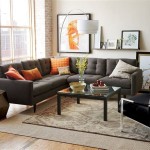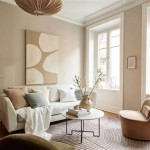Cool Color Palettes for a Refreshing Living Room Ambiance
The living room, often considered the heart of the home, serves as a space for relaxation, entertainment, and connection. The selection of a color palette significantly impacts the atmosphere and overall feel of this central area. Cool colors, characterized by their association with calmness and serenity, offer a versatile range of options for creating a refreshing and inviting living room environment. This article explores various cool color schemes, their psychological effects, and practical considerations for implementation.
Understanding the Psychology of Cool Colors
Cool colors are generally located on the blue side of the color wheel, encompassing shades of blue, green, and purple. These colors are often associated with nature, mimicking the vastness of the sky, the depth of the ocean, and the tranquility of forests. Consequently, they evoke feelings of peace, stability, and relaxation. In interior design, cool colors are frequently used to create a sense of spaciousness and airiness, making them particularly suitable for smaller living rooms or spaces that lack natural light.
Blue, perhaps the most prominent cool color, is known for its calming effect on the mind and body. It can lower blood pressure and heart rate, promoting a sense of tranquility. Different shades of blue can evoke different emotions, from the invigorating energy of turquoise to the sophisticated elegance of navy. Green, another popular cool color, is strongly linked to nature and growth. It brings a sense of balance and harmony to a space, fostering a feeling of well-being. Purple, often associated with royalty and spirituality, can add a touch of luxury and sophistication to a living room. Lighter shades of purple, such as lavender, are particularly effective in creating a relaxing and serene atmosphere.
Beyond their direct psychological effects, cool colors can also influence the perception of temperature. They tend to make a room feel cooler, which can be particularly beneficial in warmer climates or in living rooms that receive a lot of sunlight. By strategically utilizing cool colors, designers can create a living space that is not only aesthetically pleasing but also conducive to relaxation and comfort.
Exploring Different Cool Color Schemes
The application of cool colors in a living room can be achieved through various color schemes, each offering a distinct aesthetic and emotional impact. Monochromatic schemes, analogous schemes, and complementary schemes are among the most common approaches.
A monochromatic cool color scheme involves the use of different shades and tints of a single cool color. For example, a living room could feature walls painted in a light blue, complemented by furniture in a darker navy blue and accessories in a pale sky blue. This approach creates a cohesive and harmonious look, emphasizing simplicity and elegance. To avoid monotony, it is crucial to incorporate textures and patterns that add depth and visual interest. Different fabric types, such as velvet, linen, and cotton, can introduce subtle variations that enhance the overall aesthetic.
An analogous cool color scheme utilizes colors that are adjacent to each other on the color wheel. This could involve combining blue, green, and turquoise, or blue, purple, and lavender. Analogous schemes create a sense of harmony and flow, as the colors naturally blend together. The key to a successful analogous scheme is to select one dominant color and use the other colors as accents. This prevents the space from feeling overwhelming or chaotic. For instance, a living room could feature walls painted in a soft green, with furniture upholstered in a muted blue and accents in a subtle turquoise.
A complementary cool color scheme involves pairing a cool color with its opposite on the color wheel. For instance, blue and orange, green and red, or purple and yellow. Complementary schemes create a sense of dynamic contrast, adding energy and visual interest to a space. While complementary schemes can be striking, they require careful balancing to avoid clashing or overwhelming the room. Typically, one color is used as the dominant hue, while the complementary color is used sparingly as an accent. For example, a living room could feature walls painted in a neutral gray-blue, with accents of warm orange in the form of throw pillows, artwork, or decorative objects.
Furthermore, the inclusion of neutral colors, such as white, gray, and beige, is essential for balancing and grounding cool color schemes. These neutrals provide a visual break, preventing the space from feeling too intense or overwhelming. They also serve as a blank canvas, allowing the cool colors to stand out and shine. The specific choice of neutral color will depend on the overall aesthetic of the living room, with white providing a crisp and clean look, gray offering a sophisticated and modern feel, and beige creating a warm and inviting atmosphere.
Practical Considerations for Implementing Cool Colors
When implementing cool colors in a living room, several practical considerations should be taken into account to ensure a successful and harmonious result. These considerations include the size of the room, the amount of natural light available, and the existing architectural features.
The size of the living room plays a crucial role in determining the appropriate shade and intensity of cool colors. In smaller living rooms, lighter shades of cool colors, such as pale blue or mint green, are generally preferred, as they help to create a sense of spaciousness and airiness. Darker shades of cool colors, such as navy blue or deep purple, can make a small room feel even smaller and more enclosed. However, in larger living rooms, darker shades can be used effectively to create a sense of drama and sophistication. The key is to balance the use of dark and light shades to prevent the space from feeling either too cramped or too cavernous.
The amount of natural light available in the living room is another important factor to consider. Rooms with ample natural light can accommodate a wider range of cool color shades, as the natural light will help to brighten and illuminate the space. However, in living rooms that lack natural light, lighter shades of cool colors are essential for preventing the space from feeling dark and gloomy. Artificial lighting can also be used to supplement natural light and enhance the overall brightness of the room. Warm-toned light bulbs can help to balance the cool tones of the walls and furniture, creating a more inviting and comfortable atmosphere.
The existing architectural features of the living room, such as the flooring, trim, and fireplace, should also be taken into account when selecting a cool color palette. The colors of these features should complement or contrast with the cool colors chosen for the walls and furniture. For example, if the living room has hardwood floors with warm undertones, a cool color palette with hints of warm neutrals can help to create a balanced and harmonious look. Similarly, if the living room has white trim, a cool color palette with light and airy shades can enhance the overall sense of freshness and cleanliness.
Furthermore, the choice of furniture and accessories plays a significant role in complementing a cool color scheme. Furniture in natural materials, such as wood, rattan, and wicker, can add warmth and texture to the space, preventing it from feeling too sterile or clinical. Accessories in complementary colors, such as throw pillows, artwork, and rugs, can add pops of visual interest and create a more dynamic and engaging atmosphere. The key is to strike a balance between cool and warm tones, creating a living room that is both relaxing and visually appealing. The incorporation of plants can also significantly enhance the cool color palette, bringing a sense of life and freshness to the space. Green foliage complements cool colors beautifully and helps to create a connection with nature.
In conclusion, the effective use of cool colors in a living room can transform the space into a haven of tranquility and relaxation. By understanding the psychology of cool colors, exploring different color schemes, and considering practical implementation factors, individuals can create a living room that is both aesthetically pleasing and conducive to well-being. The careful selection and application of cool colors, combined with thoughtful consideration of lighting, furniture, and accessories, can result in a living room that is not only beautiful but also a true reflection of personal style and preferences.

30 Living Room Paint Colours Inspiration For An Inviting Space Beamin Moore
:max_bytes(150000):strip_icc()/AngelaNewtonRoy-64e3b82a356c4b0cb1b0fd56c2771b8d.jpg?strip=all)
7 Best Living Room Paint Colors According To Designers

Living Room Paint Colors Ideas The Home

2025 Color Collection Of The Year Hgtv Home By Sherwin Williams

Best Living Room Paint Colors For 2024 Brock Built

Guide To Warm And Cool Paint Colors Beamin Moore

The Best Living Room Color Ideas Out There Purewow

These Two Living Room Colors Are The Perfect Combo Clare

9 Fashionably Cool Living Room Color Palettes

From The Pros Top 10 Living Room Paint Colors Decorilla Online Interior Design








